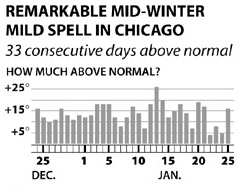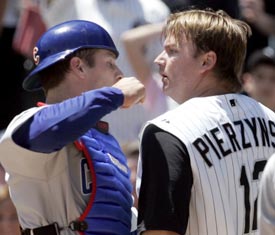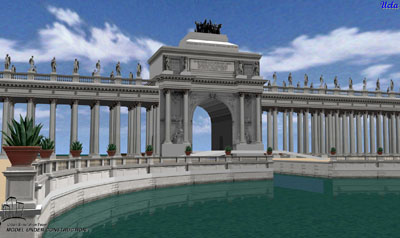Crosstown classless
“Say there, A.J., how are ya? Congrats on the World Series and all that. I was wondering, do you wear the championship right on this finger or this finger?” Whack!
Urban scar tissue
[Update: Before you send me a nastygram about being a suburban-bound latte-swilling cretin, maybe read a little more closely. I’m a huge fan of the train and urban transportation in general. Scar tissue is a metaphor, not a value judgment.]
A little over a decade ago I helped build six single-family homes in Chicago on Melrose St. just east of Lakewood Ave. We were driving posts into the dirt for a fence on an irregular diagonal property border when we hit something solid that turned out to be a railroad tie. We later learned that the screwy lot line was the result of surface train tracks that once cut through the area, the remains of which we had dug up.
I was reminded of this today by this great satellite image of the urban tissue of San Francsico reassimilating land once used by railroad tracks. Sure enough when you scale back a bit you see the same evidence of “healing” from the area around where I worked on the homes in Chicago. Roads, parking lots, buildings, row houses and, ultimately, the front door of Wrigley Field all conform to the serpentine crawl of the former track.
[Full map.]

Most interesting is that this urban scar tissue is actually part of what you might call a festering wound: a four-block portion of the line (south of this image) is still in operation serving a single customer. The path follows the route of the old Chicago & Evanston Railroad line and the functioning spur is called the Lakewood Branch. The only thing that runs on it is the Sugarland Express, a train that delivers sugar and corn syrup to the Peerless Confection Company twice weekly. Even so, the city is trying to heal over it. When the sugar train comes through residents must move their cars off portions of the tracks that serve as parking lots most of the rest of the week.
Everyone stand back, I’m a chef
This morning on the L train a woman collapsed at my feet. In my iPod-cocoon I admit I only realized this as I saw commuters’ faces looking at the floor near me. I’ve seen other people faint on the train before (must have something to do with the motion), but this time I was impressed by the reaction of the bystanders. Almost immediately and without a leader to delegate, individual tasks were assumed by the commuters in the immediate vicinity. An off-duty CTA worker jumped on his cell to contact the line operator, the person nearest the intercom alerted the conductor, the woman next to me stooped down to hold the woman’s hand and comfort her, and a doctor knelt down to figure out what was going on.
At least, we thought he was a doctor. I mean, he had a white coat and a badge and looked very authoritative. As I looked closer I saw that the white coat was the double-breasted kind that chefs wear. (He had it unbuttoned which made it look more like a lab coat.) His profession was confirmed by the kooky pants chefs (and bodybuilders and MC Hammer) sometimes wear. What was I going to do, interject “Hey wait a minute this guy’s a chef! And probably a line chef too! Back off, pal!” Would he take her vital signs with his meat thermometer? Dab her sweat with his toque? I just stood back, mentally blogging (hey, I needed a role too) and thought about how both wonderful and somewhat frightening it is that initiative counts for more than expertise in matters of leadership.
We transferred the woman, who we learned was pregnant and probably suffering a blood sugar dip, to trained medical personnel at the next platform.
I heard a rumor
Last night the house on our part of the block one street over burnt down. As I’ve come to expect from our city’s first responders, the number of emergency vehicles might have caused you to think that an entire block had been napalmed. Dozens of fire engines and even more squad cars clogged every part of Damen Ave. from Belmont to Roscoe. Curious, of course, I sidled up to a group of bystanders listening to a cop. Here’s the gist.
Cop: “… firecracker.”
Me: “Hey, I live one block over. Is everyone OK? Did you just say this was caused by a firecracker?”
Cop: “Yeah, everyone’s fine. No, firecracker is what we call people who flip us the bird from the window like that woman over there.” Points.
Me: “How did this happen?”
Bystander: “I don’t want to start any rumors, but she had a lot of cats. Lots of cats.”
Me: “Cats don’t start fires.”
Bystander: “Look, that’s all I’m gonna say. I don’t like rumors. But she has a lot of cats and she’s been in the news. If you know what I mean.”
Me: Pause. “My house got a little wet from the fire hoses. Could have been worse I guess.”
Same Bystander: “Oh yeah? Any water damage? Here’s my card. I’m an adjuster.”
Me: “My god, you’re like an ambulance chaser for fires.”
Bystander: “Hey, I live in the neighborhood.”
Entropy of winter
I’m of what you might call the local school of meteorology. Yes, yes, I understand that butterflies cause nasty weather halfway around the globe and that my Right Guard has carved a hole in Earth’s jacket of O3. And I understand that tornados do not actually chase people nor hurricanes punish communities for being un-Christian. Yet, I can’t shake the sense that weather behaves locally.
For example, consider the bizarre mid-winter temperature spike here in Chicago.

Weather, being just a manifestation of energy, obeys the first law of thermodynamics and so it follows that weather, like energy, is not created or destroyed, just moved around. A scientist would tell you that someplace else in the world is getting screwed because Chicago weather was so different in January.
But not me. I’m more local. I don’t trust the balmy weather because I know the conservation of energy is local to Chicago. Why would the weather gods punish anyone but us for our high-energy month? We’ll suffer a below-zero March or four feet of snow in April. Chicago weather punishes its own. We’re part of a closed system. Bundle up!
Ultimate snowball
Last night, as the snow came down in buckets, a friend commented on how perfect it would be to start a snowball fight against the masses huddled on the opposite L train platform. As we all waited for the delayed trains and came more and more to resemble snowmen, it seemed like a great idea. Perfect distance, a perfect no-man’s land — the electrified rails — in between the opposing armies, and in fact a perfect reason: people on the east platform were, in part, headed to the south side on the orange line. People on the west were headed to the north side on the brown. How better for Cubs fans to blow off some post-World Series steam? (Poor purple line commuters. They were going north too but were unfortunately clumped in with the orange liners. Collateral damage, I guess.) Only one problem. The snow was way too dry. You couldn’t form a snowball at all.
Pity. That would have been fun. At least until someone fell into the tracks.
Simulating a simulated city
One treat from my recent visit to UCLA was meeting the Urban Simulation Team. This small group develops detailed, precise 3D models of cities past and present for educational use, as a tool for urban planners, and even to facilitate emergency response. Their main focus is currently a complete modelling of the Los Angeles basin, but what really piqued my interest was Prof. Lisa Snyder’s “side project” to recreate the fairgrounds of the 1893 World Columbian Exposition in Chicago. She’s creating the White City — and doing a great job with limited resources.
While Leonardo di Caprio and Tom Cruise vie for the movie rights to Erik Larson’s wonderful telling of the story of Burnham, Olmstead, and proto-serial killer H.H. Holmes, Snyder patiently slaves away at the reconstruction with surprisingly scant documentation. For instance, we think of the buildings as being white, of course, which is supported by the monochrome photography of the period. But we know from architectural plans that the buildings were not uniformly white. The devil may have been in the White City, but he’s also in the details of recoloring it. Snyder has her work cut out for her.
Even in its half-finished state, the model is sublime. Viewing the fairgrounds from the gargantuan Ferris Wheel or from the elevated train or from Olmstead’s electric canal boats or from the futuristic moving sidewalk that jutted into Lake Michigan are all experiences not available with the strictly controlled photographic record of the city. The sense of scale is immediate. There’s a bleak majesty to it when you consider that it was all gone by the turn of the century. (Except for the refaced Fine Arts Building, now the Museum of Science and Industry — where, incidentally, I asked my then-girlfriend to marry me.)
I ride my bike in the area of the fairgrounds a few times each summer. There’s some historic signage and some replicated statuary, but the landscape itself is really the only place you’ll find evidence of the Expo. A long split boulevard bordering the University of Chicago marks the fair’s Midway (Snyder tells me that the concrete pads the Ferris Wheel rested on are still there, beneath the park’s sod) and neglected lagoons are evidence of Olmstead’s triumphant carving of the waterways throughout the fairgrounds. As the UST recreation of the White City proceeds one can dream of integrating it into the landscape itself, perhaps as a location-based service offered through the Chicago Park District or, better, as an outside-the-walls extension of the Museum of Science and Industry. Mapping the virtual structures onto the shadows of the fair embedded in the landscape would be a moving experience indeed.
Black Sox no longer
Last night I had the crazy notion that, with a world champion team to call their own, White Sox fans would lose the massive chip on their shoulders about the Cubs. You’d not know it these days, but Cubs fans greatly outnumber Sox fans in the city and throughout the country (thanks to years of national coverage by WGN). Wrigley Field is a tourist destination by itself and while the new new Comiskey — pardon me, The Cell — is a great park, it still doesn’t hold a candle to Cubs field and Wrigleyville. This has nothing to do with the quality of the respective sports teams, of course. It is all about the perceived sense of importance to the city. (And perhaps lingering guilt over the team’s scandalous collusion with gamblers in 1919?)
Will the inferiority complex dissipate now that the Sox are the champs?
Reluctant cheerleader
The World Series has me in a real dilemma.
Fact #1: I greatly dislike the White Sox. Or rather, I’m no fan of their fans who, you can be sure, would not be cheering on the Cubs if by some cosmic anomaly they made it to the World Series.
Fact #2: I love Chicago and I love that any of our sports teams is so dominant.
Fact #3: I am married to a woman with a great deal of family in Houston (more since Katrina) and so
must deal with a large pro-Houston lobby.
I suppose it is better than a Sox-Cardinals series. That would have been too much for any Cubs fan.
Grandpa’s gonna spin in his grave, but … Go Chicago!
The steam will rise again
Perhaps catering to its larger blue collar readership, the Sun-Times scooped the Trib in covering a story of great importance to the public bathers of the city. The good news is that the Division Street Baths are closed for remodelling and will reopen next year most likely, just in time for its 100th birthday. Thank goodness, but why on earth would they do this over the winter when we need it most?
Kudos to Greer for tracking this down. And, May, if you’re not demoted at the Tribune for dropping this particular lead I may ask my vast readership to start a blogging campaign highlighting your journalist negligence.
Viva fat sweaty men flagellating themselves with oak switches!
See also: Sensory deprivation















